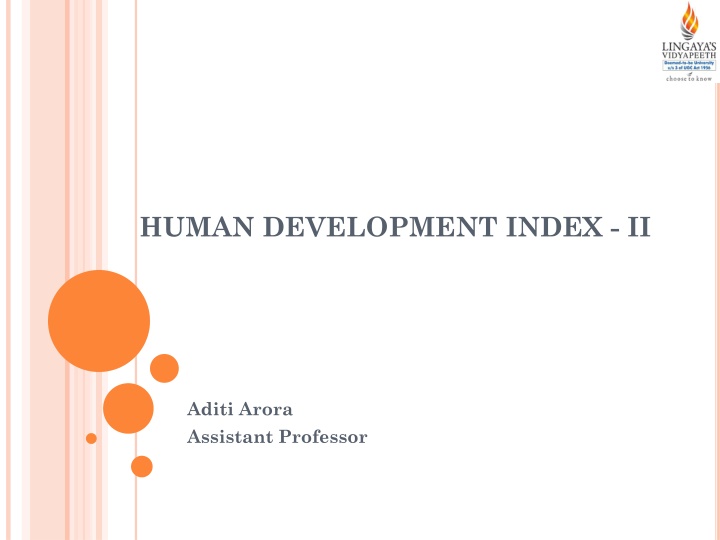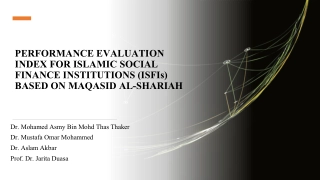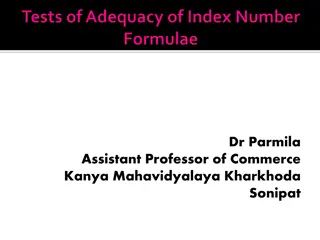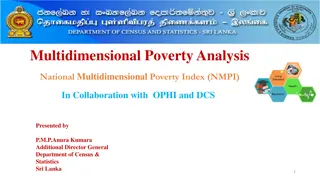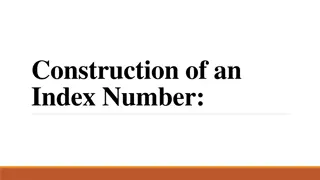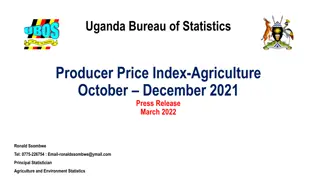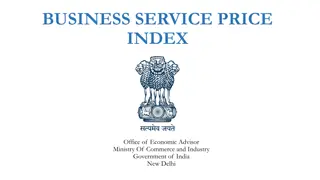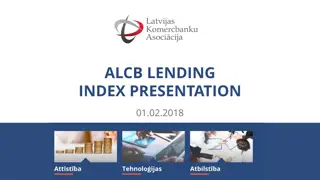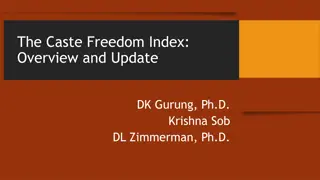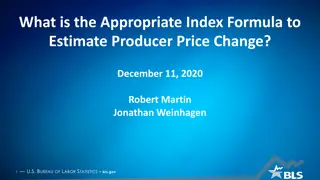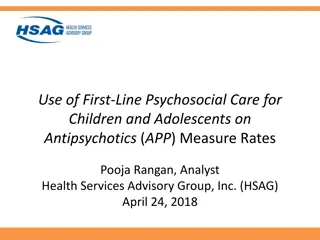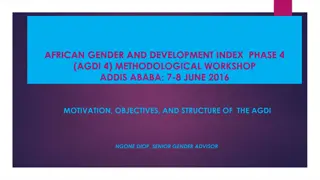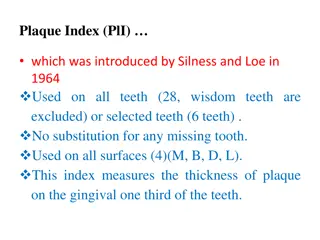Human Development Index: A Comprehensive Measure of Progress
The Human Development Index (HDI) is a vital composite measure that assesses achievements in essential dimensions like life expectancy, education, and standard of living. It aims to provide policymakers with a holistic view of human development progress and highlights areas needing urgent attention. With its construction based on key indicators like demographic factors, the HDI offers a geometric mean of aggregated indicators to present a comprehensive index for monitoring and improving human development globally. Formulated in the 1990 Human Development Report, the HDI advocates for a people-centric approach to development, emphasizing the importance of creating an enabling environment for individuals to enhance their well-being and lead fulfilling lives.
Download Presentation

Please find below an Image/Link to download the presentation.
The content on the website is provided AS IS for your information and personal use only. It may not be sold, licensed, or shared on other websites without obtaining consent from the author.If you encounter any issues during the download, it is possible that the publisher has removed the file from their server.
You are allowed to download the files provided on this website for personal or commercial use, subject to the condition that they are used lawfully. All files are the property of their respective owners.
The content on the website is provided AS IS for your information and personal use only. It may not be sold, licensed, or shared on other websites without obtaining consent from the author.
E N D
Presentation Transcript
HUMAN DEVELOPMENT INDEX - II Aditi Arora Assistant Professor
HUMAN DEVELOPMENT REPORT 1990 People are the real wealth of a nation with these words the 1990 Human Development Report of UN (HDR) began a forceful case for giving a new orientation to the development efforts. It highlighted the need for creation of a congenial environment for people to exercise their choices which they perceive as required a for their self up- gradation and thus for leading a healthy, long and creative life.
WORLD WIDE MOVEMENT TOWARDS HUMAN DEVELOPMENT HDR is the outcome of the vision and pain taking efforts put in by Dr. Mehbub ul Haq an economist from Pakistan and his collaborator Prof. Amartya Sen of India. It attempted to consolidate the suggestions emerging from the research works of like minded thinkers world wide and lay down guidelines towards development that would have a wider acceptability.
WORLD WIDE MOVEMENT TOWARDS HUMAN DEVELOPMENT A simple yet broad branded and inclusive indicator named as Human Development Index has been constructed in place of GDP, so that national policy makers are helped to keep track of success of their efforts on human development front and where found warranted to introduce appropriate policy corrections and re gigging the operations.
HUMAN DEVELOPMENT INDEX A composite measure of achievements on the three basic dimensions of human development long and healthy life, access to knowledge and be creative, and decent standard of living. For ease in comparability the average value of achievements on each of these dimensions are put on a scale of 0 to1- where the measure recorded a rise, the position in regard to the aspect in question is assumed to be as improving and in case it is close to 0 the matter is regarded as one needing urgent attention.
HUMAN DEVELOPMENT INDEX These indicators are then aggregated mostly taking their geometric mean to arrive at the composite index.
CONSTRUCTION OF HDI In the construction of HDI a number of indicators are taken into reckoning. Major ones include: Demographic : Life expectancy rate, Birth and Death rates, Infant and Maternal mortality rates and Fertility rate.
CONSTRUCTION OF HDI Health: Medical: Number of doctors , nurses, qualified birth attendants per100,000 population, Average distance a family has to travel to reach medical facility, Percentage of infants Immunised in an year against four antigens. Water Supply : Percentage of population with reasonable access to safe drinking water and sanitation. Percentage of houses with in- house facility for excreta and wastes disposal. Public expenditure on health related functions as a percentage of GDP.
CONSTRUCTION OF HDI Nutrition : Total quantum of food items available to people measured in terms of their calorie equivalent values. Average calories value of food intake per capita per day.
CONSTRUCTION OF HDI(CONTINUED) Education : Adult literacy rate, School enrolment as a percentage of children in the age group 6 to 14 years, Mean years of schooling of adults, Number of doctors, teachers and other professionally qualified personnel and the number of workers possessing various vocational skills. Income levels : Per capita income, Coefficient of income inequality Average earnings of skilled and unskilled workers
CONSTRUCTION OF HDI(CONTINUED) Employment: Strength of work force, Unemployment rate, Dependency rate Gender inequality : Sex ratio, Gender disparities in school enrollments, in adult literacy, in employment and in the earnings Public expenditure on women empowerment activities as a percentage of GDP. Housing: Percentage of slum population , Housing density, Average number of people residing in a habitable room.
SUPPLEMENTARY INDICES OF HDI Inequality adjusted HDI (IHDI) : A measure of average level of human development in a society after intra country inequalities are taken into reckoning. Greater the differences between the HDI and IHDI, it could be presumed that wider are the inequalities.
SUPPLEMENTARY INDICES OF HDI Hybrid HDI (HHDI) : HDI calculated using the new functional form described in the HDR (full report) and the same three dimensions measured in terms of life expectancy, literacy, gross school enrolment and per capita GDP. Better data availability means that the construct is more suitable for the analysis of long term trends.
SUPPLEMENTARY INDICES OF HDI Multi Purpose Poverty Index (MPPI) : A measure of serious deprivation in the dimensions of health , education and living standards that combines the number of deprived and the intensity of their deprivations.
GENDER INEQUALITY INDEX (GII) A measure intended to capture the short falls in the efforts towards promoting gender equality. This is attempted on the basis of under achievements in the targets set on the fronts of reproductive health, economic empowerment and labour force participation. The indices range from 0 to1 ie. perfect equality to perfect inequality.
GENDER INEQUALITY INDEX (GII) To highlight the importance of these measure one may quote the observation of Dr. Julious Nyerere- former President of Tanzania. It reads a person cannot walk very fast on one leg. How can we expect half of the people to develop a nation yet reality is that women are usually left aside when development needs are discussed .
LIMITATIONS OF HDI Though the HDI is an improvement over GDP, it leaves many aspects of people s choices for self development such as the demand for leisure, entertainment, travel and tourism etc. Ignored are also are the aspects pertinent for societal advancement, including the ones for guaranteeing the democratic institutions, for freedom to have religious beliefs, unshackling of strangulating restrictions imposed by tradition etc.
INDIAS PERFORMANCE India a nation that in recent years has proved its high level of proficiency in the fields of information technology, medical care, Sat light launching etc, is observed to be lagging far behind in many aspects of human development in comparison to the progress made by its fellow developing countries.
INDIAS PERFORMANCE It is at the 119 th position in the HDI rankings in descending order of 169 nations in the year2010. Also India s ranking in matters of literacy, gender inequality is observed to be much below that of Sri Lanka, China, Ghana and Bosnia.
INDIAS PERFORMANCE According to 2001 Census, the literacy among males is 75.85percent where as that percentage among the females is only 54.18. Adult labour force participation ( paid employments) is 87.1% for males and 12. 9% for females. No significant reductions are observed to be happening in recent years in the rates of Infant mortality, Maternity mortality, Morbidity incidence.
FIVE YEAR PLANS AND HUMAN DEVELOPMENT Though India s Five year Development Plans from inception have been giving emphasis on social engineering as it does towards increased economic growth no specific targets were set in the matters of the former. It only in the recent plans that one finds specific target set in regard to aspects relating to the development of human capital. Some are these are listed in the following:
FIVE YEAR PLANS AND HUMAN DEVELOPMENT Tenth Five Plan: Population growth, Literacy rate, Gender gap in literacy, Increase in the number of high quality employments, Access to safe drinking water to all villages, Increase in forest coverage. Eleventh Five year Plan: Increase in absolute number of employments, Increase in real wage rates, Reduction in school drop out rates Reduction in gender gap in literacy, Reduction in infant and maternity mortality rates, fertility rates, Provision of safe drinking water to people living in all habitations.
